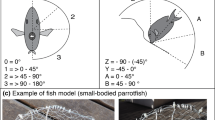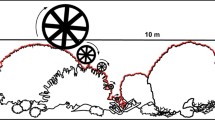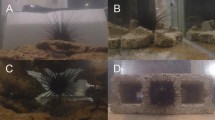Summary
Structural complexity of the habitat significantly increases population density and number of species in assemblages of predatory gastropod molluscs (families Conidae, Muricidae, Mitridae and Vasidae) on intertidal, generally smooth, horizontal limestone platforms fringing tropical Pacific islands. The important topographic features are physical (depressions partly filled with coral rubble) and biotic (thick algal turf binding sand). Higher population density and species richness in areas with than without such natural refuges, and following experimental addition of artificial refuges on portions of habitat lacking them support this hypothesis. Two species of Drupa differ from the other species present in not utilizing refuges during times of physical stress; this is attributed to their depressed shell and broad, tenacious foot. Highest gastropod densities occur in steep-sided depressions and those containing much coral rubble and sand, suggesting that these are important qualities of refuges. We believe this is the first demonstration of how specific environmental factors affect population density and species diversity of benthic invertebrates in a coral reef-associated habitat.
Similar content being viewed by others
References
Bernstein, A.S.: Diet and competition for food among the predatory gastropods of limestone benches in Hawaii and Eniwetok. Dissertation, University of Oregon (1974)
Cernohorsky, W.O.: Marine shells of the Pacific, Vol. 1 and 2. Sydney: Pacific Publications 1971 (Vol. 1, revised)-1972 (Vol. 2)
Clarke, R.D.: Species diversity and habitat distribution of coral reef fish. Manuscript in preparation
Cody, M.L.: On the methods of resource subdivision in grassland bird communities. Amer. Nat. 102, 107–147 (1968)
Demond, J.: Micronesian reef-associated gastropods. Pacific Sci, 11, 275–341 (1957)
Fairbridge, R.W.: The encyclopedia of geomorphology, pp. 1–1295. New York: Reinhold 1968
Huffaker, C.B.: Experimental studies on predation: dispersion factors and predator-prey oscillations. Hilgardia 27, 343–383 (1958)
Kay, E.A.: The composition and relationships of marine molluscan fauna of the Hawaiian Islands. Venus 42, 94–104 (1967)
Kay, E.A.: The littoral marine molluscs of Fanning Island. Pacific Sci. 25, 260–281 (1971)
Kohn, A.J.: Environmental complexity and species diversity in the gastropod genus Conus on Indo-West Pacific reef platforms. Amer. Nat. 101, 251–259 (1967)
Kohn, A.J.: Food habits of the gastropod Mitra litterata Lamarck: Relation to trophic structure of the intertidal marine bench community in Hawaii. Pacific Sci 24, 283–286 (1970)
Kohn, A.J.: Diversity, utilization of resources, and adaptive radiation in shallow-water marine invertebrates of tropical oceanic islands. Limnol. Oceanogr. 16, 332–348 (1971)
Kohn, A.J., Nybakken, J.W.: Ecology of Conus on eastern Indian Ocean fringing reefs: diversity of species and resource utilization. Marine Biol. 29, 211–234 (1975)
Kohn, A.J., Riggs, A.C.: Morphometry of the Conus shell. Syst. Zool. 24, 346–359 (1975)
Levin, S.: Dispersion and population interaction. Amer. Nat. 108, 207–228 (1974)
Luckenbill, Y.S.: Coexistence in laboratory populations of Paramecium aurelia and its predator Didinium nasutum. Ecology 54, 1320–1327 (1973)
MacArthur, R.H., MacArthur, J.W., Preer, J.: On bird species diversity. II. Prediction of bird censuses from habitat measurements. Amer. Nat. 96, 167–174 (1962)
Miller, S.L.: Adaptive design of locomotion and foot form in prosobranch gastropods. J. exp. Mar. Biol. Ecol. 14, 99–156 (1974)
Murdoch, W.W., Evans, F.C., Peterson, C.H.: Diversity and pattern in plants and insects. Ecology 53, 819–829 (1972)
Pianka, E.R.: Convexity, desert lizards, and spatial heterogeneity. Ecology 47, 1055–1059 (1966)
Pianka, E.R.: The structure of lizard communities. Ann. Rev. Ecol. Syst. 4, 53–74 (1973)
Rex, M.A.: Predation, productivity and species diversity in deep-sea gastropods. Amer. Zool. 15, 783 (1975)
Richard, G., Salvat, B.: Bilan comparatif qualitatif et quantitatif des mollusques de récifs exterieurs d'atolls ou d'iles hautes de Polynésie Francaise. Haliotis 1, 43–44 (1971)
Risk, M.J.: Fish diversity on a coral reef in the Virgin Islands. Atoll Res. Bull. No. 153, 1–6 (1972)
Rosenzweig, M.L., Winakur, J.: Population ecology of desert rodent communities: Habitat and environmental complexity. Ecology 50, 558–572 (1969)
Salvat, B.: Études quantitatives (comptages et biomasses) sur les mollusques récifaux de l'atoll de Fangataufa (Tuamotu-Polynésie). Cahiers Pac. 14, 1–58 (1970)
Schoener, T.W.: The Anolis lizards of Bimini: Resource partitioning in a complex fauna. Ecology 49, 704–726 (1968)
Smith, C.L., Tyler, J.C.: Space resource sharing in a coral reef fish community. Bull. Nat. Hist. Mus. Los Angeles Co. 14, 126–170 (1972)
Smith, C.L., Tyler, J.C.: Succession and stability in fish communities of dome-shaped patch reefs in the West Indies. Amer. Mus. Novit. No. 2572, 1–18 (1975)
Smith, F.E.: Spatial heterogeneity, stability, and diversity in ecosystems. Trans. Conn. Acad. Arts Sci. 44, 307–336 (1972)
Smith, S.V.: Carbon dioxide dynamics: A record of organic carbon production, respiration, and calcification in the Eniwetok reef flat community. Limnol. Oceanogr. 18, 106–120 (1973)
Smith, S.V., Marsh, J.A.: Organic carbon production on the windward reef flat of Eniwetok Atoll. Limnol. Oceanogr. 18, 953–961 (1973)
Stearns, H.T.: Decadent coral reef on Eniwetok Island, Marshall group. Bull. Geol. Soc. Amer. 56, 783–788 (1945)
Talbot, F.H.: A description of the coral structure of Tutia Reef (Tanganyika, East Africa) and its fish fauna. Proc. Zool. Soc. London 145, 431–470 (1965)
Wiebe, W.J., Johannes, R.E., Webb, K.L.: Nitrogen fixation in a coral reef community. Science 188, 257–259 (1975)
Author information
Authors and Affiliations
Rights and permissions
About this article
Cite this article
Kohn, A.J., Leviten, P.J. Effect of habitat complexity on population density and species richness in tropical intertidal predatory gastropod assemblages. Oecologia 25, 199–210 (1976). https://doi.org/10.1007/BF00345098
Received:
Issue Date:
DOI: https://doi.org/10.1007/BF00345098




